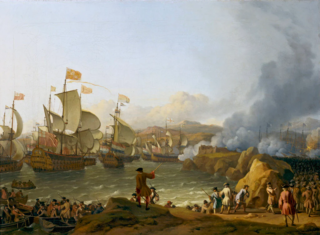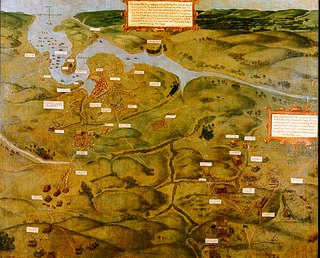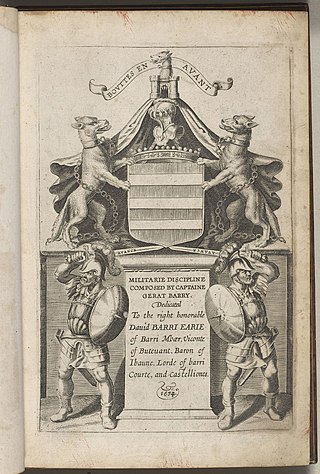
1601 (MDCI) was a common year starting on Monday of the Gregorian calendar and a common year starting on Thursday of the Julian calendar, the 1601st year of the Common Era (CE) and Anno Domini (AD) designations, the 601st year of the 2nd millennium, the 1st year of the 17th century, and the 2nd year of the 1600s decade. As of the start of 1601, the Gregorian calendar was 10 days ahead of the Julian calendar, which remained in localized use until 1923.

HMS Warspite was one of five Queen Elizabeth-class battleships built for the Royal Navy during the early 1910s. Completed during the First World War in 1915, she was assigned to the Grand Fleet and participated in the Battle of Jutland. Other than that battle, and the inconclusive Action of 19 August, her service during the war generally consisted of routine patrols and training in the North Sea. During the interwar period the ship was deployed in the Atlantic Ocean and the Mediterranean Sea, often serving as flagship, and was thoroughly modernised in the mid-1930s.

The naval Battle of Gibraltar took place on 25 April 1607, during the Eighty Years' War, when a Dutch fleet surprised and engaged a Spanish fleet anchored at the Bay of Gibraltar. During the four hours of action, most of the Spanish ships were destroyed.

The Battle of Vigo Bay, also known as the Battle of Rande, was a naval engagement fought on 23 October 1702 during the opening years of the War of the Spanish Succession. The engagement followed an Anglo-Dutch attempt to capture the Spanish port of Cádiz in September in an effort to secure a naval base in the Iberian Peninsula. From this station the Allies had hoped to conduct operations in the western Mediterranean Sea, particularly against the French at Toulon. The amphibious assault, however, had proved a disaster, but as Admiral George Rooke retreated home in early October, he received news that the Spanish treasure fleet from America, laden with silver and merchandise, had entered Vigo Bay in northern Spain. Philips van Almonde convinced Rooke to attack the treasure ships, despite the lateness of the year and the fact that the vessels were protected by French ships-of-the-line.

The Anglo-Spanish War (1585–1604) was an intermittent conflict between the Habsburg Kingdom of Spain and the Kingdom of England that was never formally declared. It began with England's military expedition in 1585 to what was then the Spanish Netherlands under the command of the Earl of Leicester, in support of the Dutch rebellion against Spanish Habsburg rule.

The siege of Kinsale, also known as the battle of Kinsale, was the ultimate battle in England's conquest of Gaelic Ireland, commencing in October 1601, near the end of the reign of Queen Elizabeth I, and at the climax of the Nine Years' War—a campaign by Hugh O'Neill, Hugh Roe O'Donnell and other Irish lords against English rule.

In the Battle of Cape Finisterre off Galicia, Spain, the British fleet under Admiral Robert Calder fought an indecisive naval battle against the combined Franco-Spanish fleet which was returning from the West Indies. Failing to prevent the joining of French Admiral Pierre de Villeneuve's fleet to the squadron of Ferrol and to strike the shattering blow that would have freed Great Britain from the danger of an invasion, Calder was later court-martialled and severely reprimanded for his failure and for avoiding the renewal of the engagement on 23 and 24 July. At the same time, in the aftermath Villeneuve elected not to continue on to Brest, where his fleet could have joined with other French ships to clear the English Channel for an invasion of Great Britain.
Dreadnought was a 41-gun galleon of the Tudor navy, built by Mathew Baker and launched in 1573. Like HMS Dreadnought of 1906, she was a radical innovation over contemporary ships. When John Hawkins became Treasurer of the Navy in 1577, he had sailed all over the world, and his ideas contributed to the production of a new race-built series of galleons—of which Dreadnought was the second, following Foresight of 1570—without the high forecastle and aftcastle prevalent in earlier galleons. These "marvels of marine design" could reputedly "run circles around the clumsier Spanish competition."

The Battle of St. Lucia or the Battle of the Cul de Sac was a naval battle fought off the island of St. Lucia in the West Indies during the American Revolutionary War on 15 December 1778, between the British Royal Navy and the French Navy.

Garret Barry, also called Gerat, was an Irish soldier and military writer, who fought for Spain in the Eighty Years' War and then for the Irish insurgents in the Rebellion and the Confederate Wars. When young he left Kinsale at its surrender in 1602 for Spain where he took service, first as marine in the Atlantic Fleet and then in the Army of Flanders. While in Spanish service, he fought at the Siege of Breda in 1624/1625. He retired with the rank of captain in 1632. Returning to Ireland he was at the Rebellion appointed general of the insurgents' Munster Army. He took Limerick in June 1642 but was defeated at Liscarroll by Inchiquin in September. He was confirmed as General of the Munster Army by the Irish Catholic Confederation but was in practice superseded by Castlehaven in 1643.

James Fort is an early 17th-century pentagonal bastion fort located on Castlepark peninsula in Kinsale harbour, County Cork, Ireland. Situated downstream from Kinsale on the River Bandon, the fort was built to defend the harbour and seaborne approaches of the town. Following the construction of Charles Fort on the opposite side of the harbour in the late 17th century, James Fort became known as the "old fort". Listed as a protected National Monument, and managed by the Office of Public Works, the fort is open to visitors.

The Spanish Armada was a Spanish fleet that sailed from Lisbon in late May 1588, commanded by the Duke of Medina Sidonia, an aristocrat without previous naval experience appointed by Philip II of Spain. His orders were to sail up the English Channel, join with the Duke of Parma in Flanders, and escort an invasion force that would land in England and overthrow Elizabeth I. Its purpose was to reinstate Catholicism in England, end support for the Dutch Republic, and prevent attacks by English and Dutch privateers against Spanish interests in the Americas.

Warspite was a great ship of the English Tudor navy. The vessel was built at Deptford Dockyard by the master shipwright Edward Stevens and launched about 1 March 1596. She carried a crew of 300 when at sea, of whom 190 were classed as "mariners", manning the guns and fighting the ship; 80 as "sailors", working the sails and ancestors of present-day seamen and 30 "gunners", the armament specialists.

Juan Del Águila (d'Aguila) y Arellano was a Spanish general. He commanded the Spanish expeditionary Tercio troops in Sicily then in Brittany, before serving as general of the Spanish armies in the invasion of Ireland (1600–1602). As a soldier, and subsequently Maestre de campo of the Tercios, he was posted to Sicily, Africa, Malta, Corsica, Milan, the Netherlands, Spain, Portugal, France and Ireland, where he participated in major military events of his time, such as the Siege of Malta, the Looting of Antwerp, the Siege of Antwerp, the "Miracle of Empel", an expedition in support of the French Catholics during the French Wars of Religion, the Raid on Mount's Bay and another one in support of Irish clans during the Nine Years War.

The Battle of Orbetello, also known as the Battle of Isola del Giglio, was a major naval engagement of the Franco-Spanish War of 1635. It was fought on 14 June 1646 off the Spanish-ruled town of Orbetello, on the coast of Tuscany, Italy, between a French fleet led by Admiral Armand de Maillé, Marquis of Brézé, and a Spanish fleet commanded by Miguel de Noronha, 4th Count of Linhares sent to break the blockade of Orbetello and relieve the town, besieged since 12 May by a French army under the command of Prince Thomas of Savoy. The Battle of Orbetello was tactically very unusual, since it was fought by sailing ships towed by galleys in a light breeze.

The Battle of Santa Cruz de Tenerife was a military operation in the Anglo-Spanish War (1654–60) which took place on 20 April 1657. An English fleet under Admiral Robert Blake penetrated the heavily defended harbour at Santa Cruz de Tenerife in the Spanish Canary Islands and attacked their treasure fleet. The treasure had already been landed and was safe but the English engaged the harbour forts and the Spanish ships, many of which were scuttled and the remainder burnt. Having achieved his aim, Blake withdrew without losing any ships.

Sir Richard Leveson was an important Elizabethan Navy officer, politician and landowner. His origins were in the landed gentry of Shropshire and Staffordshire. A client and son-in-law of Charles Howard, 1st Earl of Nottingham, he became Vice-Admiral under him. He served twice as MP for Shropshire in the English parliament. He was ruined by the burden of debt built up by his father.

The Battle of the Narrow Seas, also known as the Battle of the Goodwin Sands or Battle of the Dover Straits was a naval engagement that took place on 3–4 October 1602 during the Anglo-Spanish War of 1585 and part of the Dutch Revolt. An English fleet under Sir Robert Mansell intercepted and attacked six Spanish galleys under the command of Federico Spinola in the Dover Straits. The battle was fought initially off the coast of England and finally off the Spanish Netherlands. The English were soon joined by a Dutch fleet under Jan Adriaanszoon Cant, and they completed the destruction.

The Battle of Sesimbra Bay was a naval engagement that took place on 3 June 1602, during the Anglo-Spanish War. It was fought off the coast of Portugal between an English naval expeditionary force sent out with orders by Queen Elizabeth I to prevent any further Spanish incursions against Ireland or England itself. The English force under Richard Leveson and William Monson met a fleet of Spanish galleys and a large carrack at Sesimbra Bay commanded by Álvaro de Bazán and Federico Spinola. The English were victorious in battle, sinking two galleys, forced the rest to retreat, neutralized the fort, and captured the carrack in what was the last expedition to be sent to Spain by orders of the Queen before her death the following year.

The 3rd Spanish Armada, also known as the Spanish Armada of 1597, was involved in a major naval event that took place between 18 October and 15 November 1597 as part of the Anglo–Spanish War. The attack of the armada, which was the third attempt by Spain to invade or raid the British Isles during the war, was ordered by King Philip II of Spain in revenge for the English attack on Cadiz following the failure of the 2nd Spanish Armada the previous year due to a storm. The Armada was executed by the Adelantado, Martín de Padilla, who was hoping to intercept and destroy the English fleet under Robert Devereux the 2nd Earl of Essex as it returned from the failed Azores expedition. When this was achieved, the Armada would go on to capture either the important port of Falmouth or Milford Haven and use those places as a base for invasion.



















